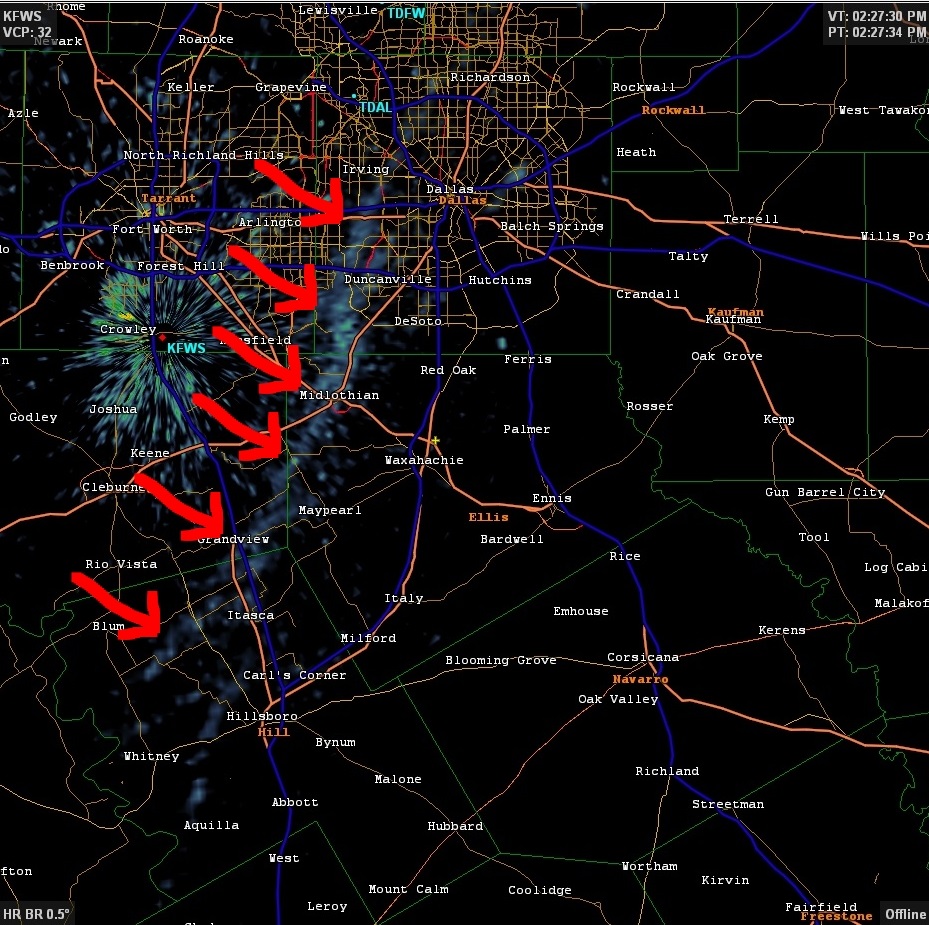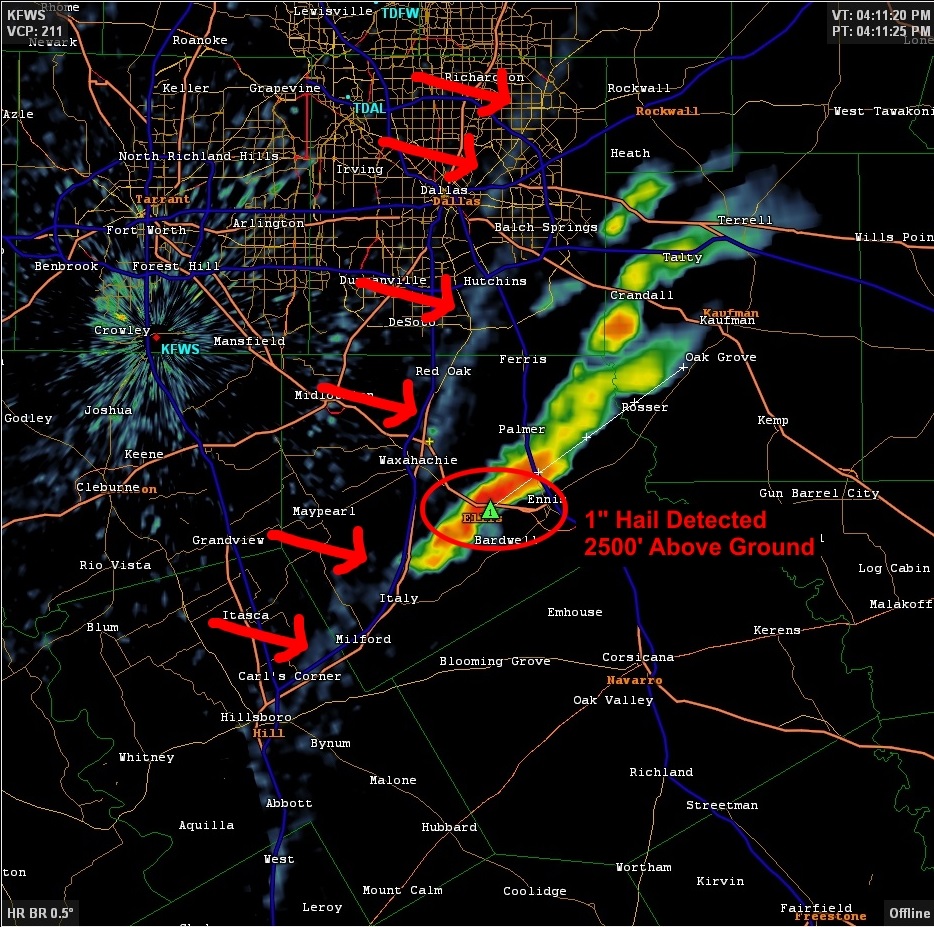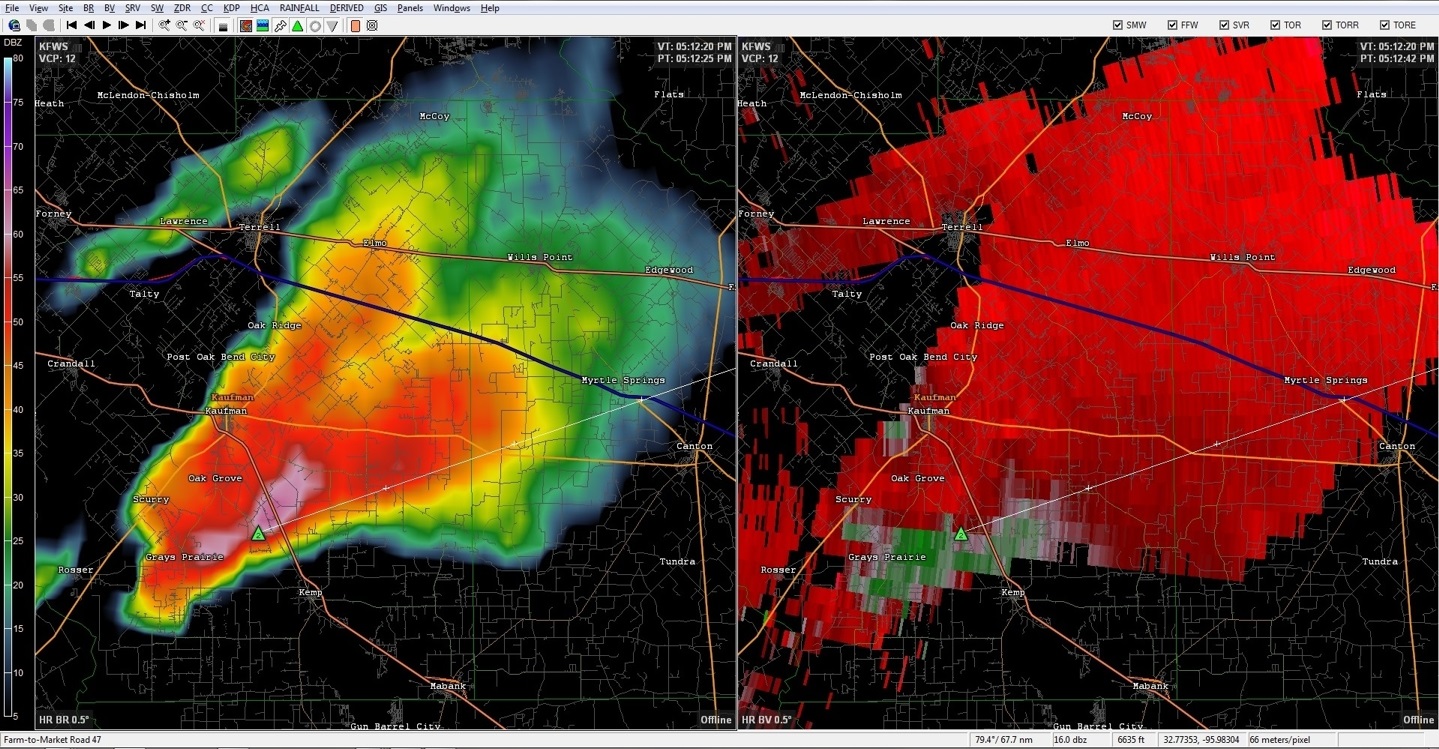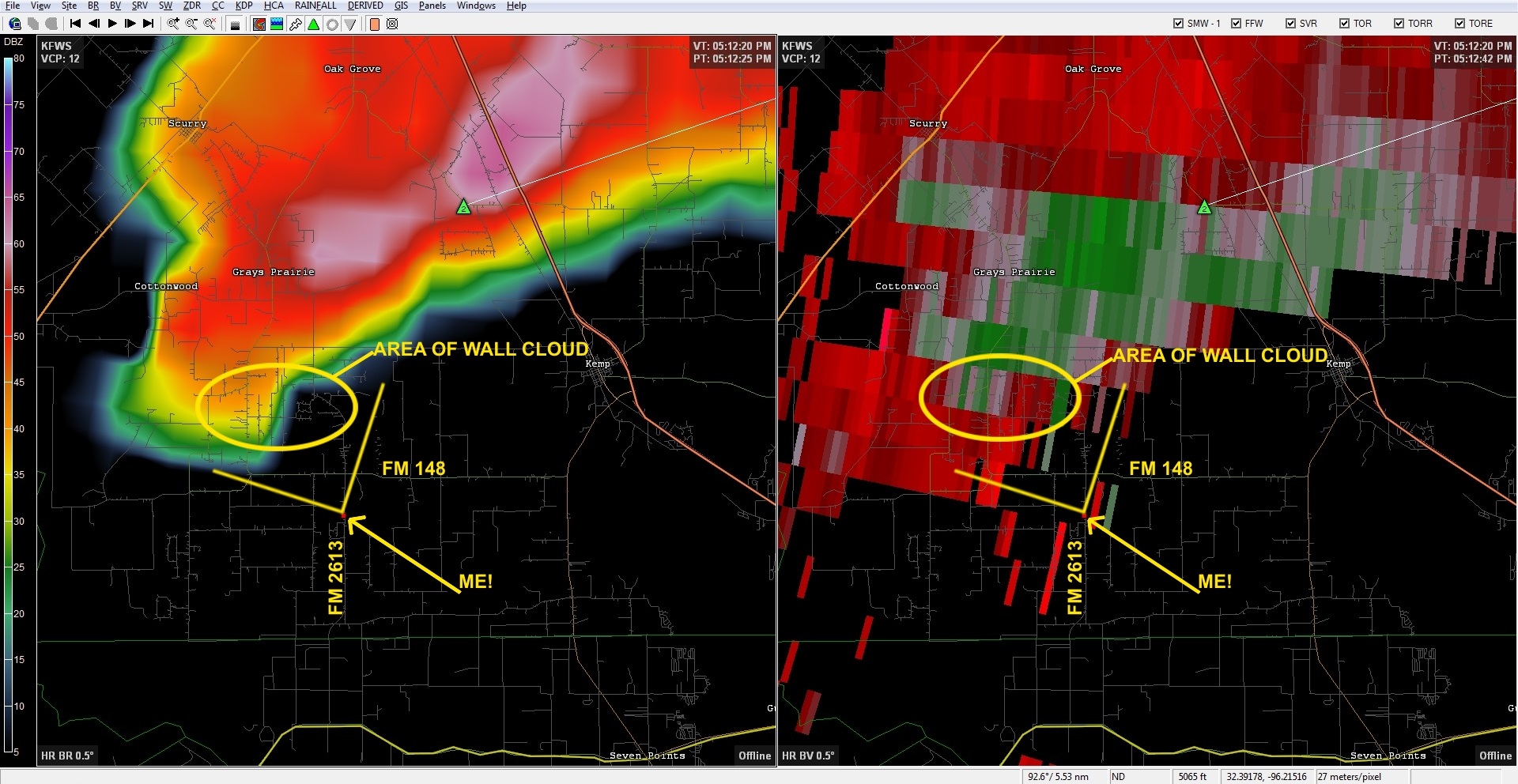Doppler radar works on a very simple principal - "speaking" and "listening". In essence, the radar "speaks" by sending out pulses of electro-magnetic energy (microwaves) to some target. Most of that energy is scattered, but a small portion is reflected back to the radar site where it is "heard". The amount of returned data (e.g. how loud the echo is) is called "reflectivity" and is measured in units of decibels of Z or dBZ. This VERY basic example is done thousands of times per second at the speed of light. In fact, a WSR-88D radar is "speaking" for just about 7 seconds per hour and the remaining 59 minutes, 53 seconds is spent "listening" for any returned signals. Because we know the speed at which these signals are sent (the speed of light) and the time it takes for the signals to return (and something else called a Phase Shift) we can also determine if an object is stationary or moving towards or away from the radar and the speed its moving . Isn't math AWESOME??
Let's take a look at what reflectivity and velocity look like in real-world examples. Here is a screen shot of a supercell thunderstorm approaching Oklahoma City on May 7, 2014. The left pane is showing reflectivity - or the intensity of the echoes being returned to the radar. The right pane is radial velocity - showing winds blowing toward the radar (GREEN) or away from the radar (RED). While these two different views are looking at the same space and time, the information they show is vastly different. The full resolution image can be found here.
Let's zoom in on reflectivity...(full resolution)
In reflectivity mode the color scale is completely arbitrary, but it's generally agreed upon that warmer colors indicate higher reflectivity and cooler colors indicate areas of lower reflectivity. Using that model, we can see that cities like Spencer, OK and Mustang, OK are getting this heaviest precipitation, while cities like Piedmont, OK and Bridge Creek, OK are getting very little precipitation.
In velocity mode, keeping in mind that green indicates winds blowing toward the radar and red indicates winds that are blowing away from the radar, we can clearly see that the area by Bridge Creek has winds blowing "inbound" and by Tuttle, the windows are blowing "outbound". This is actually an area of broad circulation that should be watched as it could potentially tighten in turn into a tornado.
Here's a close up of that area with the wind directions annotated. With the arrows present, the rotation becomes much more apparent.
Reflectivity and Velocity products are very adept at telling meteorologists what is happening - however, they're lacking in some critical information. However, in 2013, a major upgrade to the network of WSR-88D's was completed. This "Dual-Pol" upgrade (short for Dual Polarization) gave meteorologists a number of new tools to help identify more accurately what the radar is "seeing". Before the upgrade, the beam that the radar was sending out was only polarized in one direction (let's say horizontal). Therefore, the radar could only measure the width something it hit, not the height. Thus, critical information about the type of precipitation was lacking. Think of it this way: When a rain drop is falling, it's not perfectly spherical. Because of the effects of air resistance, a rain drop will actually become oblate. I like to think of this as a hamburger bun shape. The bigger the rain drop, the flatter (or wider) it becomes as it falls. Let's then contrast this with a hail stone of the same width. Even though both objects may be similar in width, they are not the same in height. The rain drop has a much narrower dimension vertically. A hail stone (a sphere in this basic example), has roughly the same dimensions vertically and horizontally when falling. Therefore, a single-polarized radar beam had trouble distinguishing between rain and hail.
Enter DUAL-POL. Like I stated before, this stands for Dual-Polarization. This means that the radar can "see" in both the horizontal AND vertical dimensions. Using the example above, a large rain drop will be wider than it is taller when falling. Hail will be roughly spherical in shape when it falls. Therefore, the difference between the vertical and horizontal measurements of the target can now be better distinguished and more easily identified. This "differential reflectivity" is a major benefit to the dual-polarization upgrade as meteorologists can get a better idea if an area of a storm contains heavy rain as opposed to hail. This new set of information can better assist meteorologists in the warning decision process by refining areas of more severe weather.
One other important benefit of this dual-polarization upgrade is the ability to determine how similar targets are in size and shape. For example, if in a given scan, all of the targets are roughly the same size and same shape, one can infer that the precipitation is homogeneous. Areas of rain only, can now be distinguished from areas of rain AND hail mix. This product is called "Correlation Coefficient". There are other, more technical, products that the dual-polarization upgrade offers, but for this article, I'll leave them out.
So, big deal, right? What's all the fuss? Let me wrap it all up by showing one last example. The screen shot below was taken on April 28, 2014 from the KGWX Doppler Radar near Columbus Air Force Base in Mississippi. The full resolution image is here.

This 4-pane view is looking at the same area in both space and time, but is displaying vastly different data. The upper left corner, is radar reflectivity. The upper right is radial velocity. The lower right is something called storm-relative radial velocity. This is similar to radial velocity, but it displays the speeds of the winds with the motion of the storms subtracted. This helps to identify movement of winds within a storm without having the storm motion factored in. Lastly, the lower left pane is the correlation coefficient product - one of the new dual-pol upgrade products.
Reflectivity
One key feature that this image of radar reflectivity shows is a distinct "hook echo" shape. I've annotated this in the following image. See how the rain wraps around in the shape of a hook? While this hook shape is certainly interesting, on its own, it can't give us the full picture of what's really going on.
Velocity
The velocity view, again, shows winds that are blowing toward (GREEN) and away (RED) from the radar. In this example the radar site is located well BELOW the image. This is important to know as inbound and outbound winds are measured relative to the radar site. See how in both images, you have reds and greens very close together? This is a very good indicator that there is very strong rotation present. The closer and brighter the colors are together, the stronger and tighter the winds are. Here's an annotated view:
Up to now, we have a pretty good indication that there is something major going on. However, we cant be 100% certain as we're not present to witness the actual event. Let's add the last component to see if we can get a full picture.
Correlation Coefficient
Again, this product looks at how similar in size and shape the precipitation is. For the most part, the reds and purples tell us that, yes, what we see from the reflectivity view shown earlier is just rain. The yellows and oranges shown near the top are probably hail. However, the main focus of this image is that large, gaping hole in the middle. See that blue section? This is where "similarness" of what the radar is seeing drops down dramatically. If you were to superimpose this image directly over that of the velocity data, the areas where the winds are coming together and this blue area are exactly lined up. In this example what we're seeing is a tornadic debris ball. This is "stuff" that a tornado is picking up and lofting into the air. It could be houses, it could be vehicles, it could be trees, bushes or farm animals. Regardless, this tornado was not just radar indicated, but verified by storm spotters. This debris ball signature could not be possible with out the recent dual-pol upgrade.
The dual-polarization upgrades not only were time-intensive, but they were also costly - about $50 million dollars in all. However, the wealth of new information that this technology has given and the better ability of meteorologists to improve the warning process, in my view, justifies the cost. While meteorologists never rely on radar data alone in the warning decision process, important upgrades like dual-pol help to verify and substantiate reports from the public and most importantly save lives.
-Andrew























